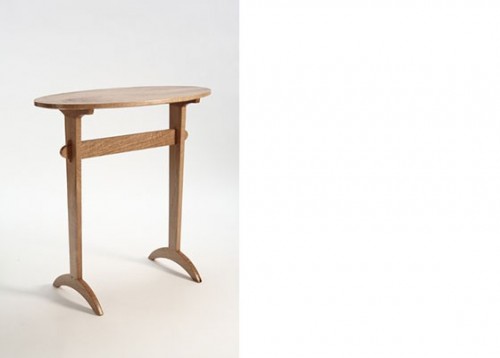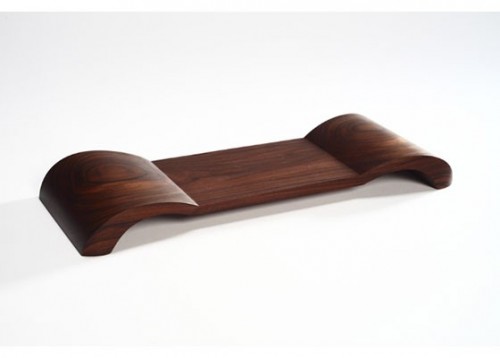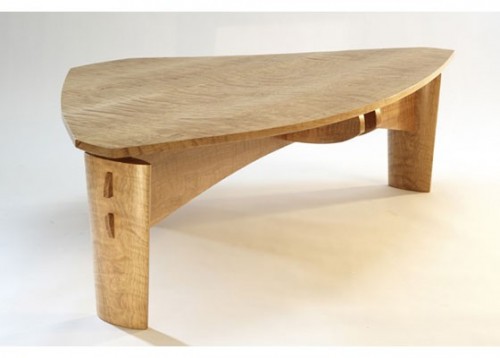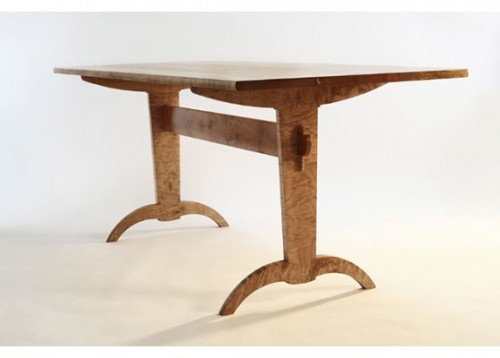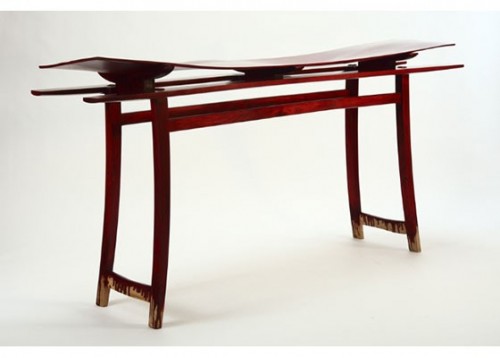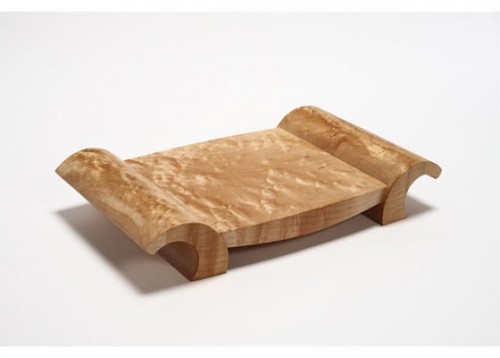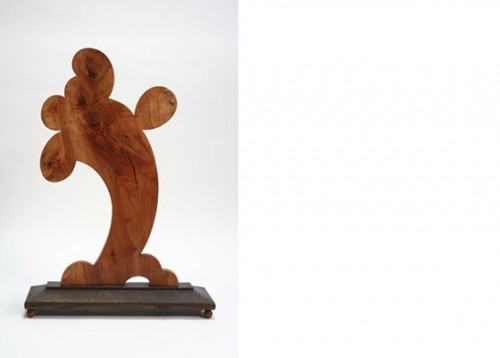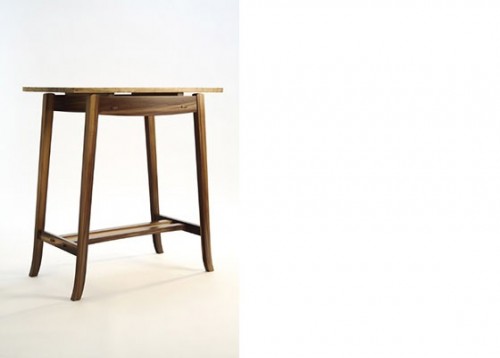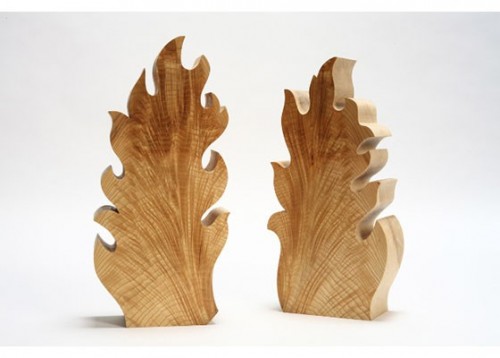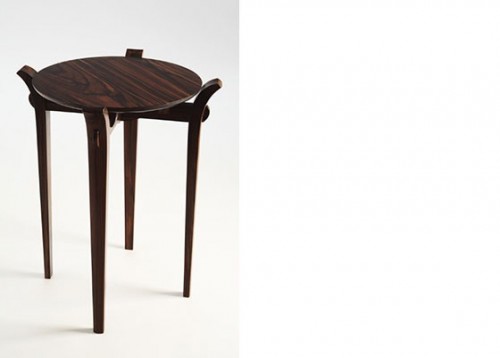Hank Gilpin Furniture at Gallery NAGA
Elegant New and Commissioned Projects
By: Mark Favermann - Oct 01, 2009
Rhode Island-based Hank Gilpin is a rare artist/designer. In the last 30 years or so, he has had over 2000 commissions for his lushly beautiful and highly touchable wood furniture and table objects. Wood does not really describe the quality and finish of the materials that Gilpin uses, polishes and refines.
Until now, he has been so busy with his individual commissions that he has not wanted to develop his work to have a one man show. Gallery NAGA, the preeminent Studio Furniture Gallery in North America, is celebrating Hank Gilpin's work with his first gallery exhibit from October 9 to November 7. 2009 at 67 Newbury Street in Boston's Back Bay.
During the three decades that Mr. Gilpin has made furniture to order, he has created, designed and fabricated pieces for clients throughout the United States. Selected works of his have been exhibited in numerous museum and group shows. The vast majority of his pieces are in private or corporate collections and therefore viewed by a limited audience. Gallery NAGA's first solo show of his work presents both new works and a sampling of his previously commissioned works.
Unlike many other studio furniture makers, Gilpin starts with the material, the wood, and creates a form from that rather than as most other studio furniture makers do, decides upon a form and then chooses a material. Gilpin is truly a man of the woods.
His knowledge of and skill in dealing with unique wood materials are unique to his work. This is added to by his creative flair that expresses a robustness and vitality that comes forth from each of his pieces. His use of waxes, coatings, stains and polishes are literally a form of painting that brings out the inherent visual quality within the wood materials.
There is a rather visceral aspect, an almost primitively pure, primeval distinctiveness to his individual works. Each of his pieces is an object that is either a scuptural furniture element or a furniture sculpture. Each one has a singular quality, a specific visual presence.
They not only make a physical statement of form, but they exhibit an inner beauty informed and therefore enhanced by their material and its sensitive and often bold fabrication and refinement. Gilpin's medium, his various common, exotic and unusual woods, is a strong part of his sculptural message.
Hank Gilpin is about touching as well as seeing his work. The feel, the touch, the physical connection is very important to artistic vision. He wants the viewer to touch his work literally and perhaps viscerally. His perspective is as unique as his art. He is interested in where and how the wood is found and harvested as how he can use it to make a visual statement.
To do this, Hank has a network throughout North America to "find" appropriate wood for his work. As well as using exotic and high quality woods like redwood and ebony, Gilpin loves using what is considered waste or low quality wood, pallet woods, before they are cut into pallet pieces. In all cases he adds his creative magic to bring the essence from the wood material as an integral if not visceral part of the finished sculptural object.
Gilpin tells a story about the only bench in the Gallery NAGA show that expresses much about his personal approach to his work. The bench was one of several for a corporate client. The client had a corporate campus that had trees all over it, a woods. The client was going to remove many of the trees for construction and landscaping of the property. The trees were going to be thrown away. Gilpin requested the wood from the trees so that he could create the benches for the site. The result was the beautiful piece of furniture that is the bench set at the gallery.
In a conversation with me, I pointed out to Hank Gilpin that there was a certain Arts and Crafts quality to the bench and several others of his pieces. Gilpin smiled and said that he was an Arts and Crafts kind of guy. He said that the greatest early and continued influence on his work was the exquisite furniture by Greene & Greene (read www.berkshirefinearts.com: Greene & Greene at the Boston Museum of Fine Arts, A New And Native Beauty Expressed in Art and Craft, 7/16/09).
He loved the show at the MFA. He even lived at the Greene Brothers' greatest house, The Gamble House, for a while in the 1970's. There is certainly a spiritual placing of hands from the Greenes' love of materials, especially wood, and Hank Gilpin's affinity for sensuous and rich woods as well as the mutual simplicity and integrity of pure form.
Hank Gilpin came to his craft like so many of the best artists and designers in a circuitous way. In the 1980's, he studied journalism at Boston University. After graduating, he served in the US Army during Viet Nam. After his two years of service, he thought that he wanted to be a photographer. He enrolled at RISD. Soon after entering, he became interested in furniture making. The love affair has continued ever since. Studio furniture master Judy McKie studied painting at RISD as well. Hank Gilpin lives and works in Lincoln, RI.
In order to learn more from this master of wood and form, Gallerist Arthur Dion asked Hank Gilpin a series of penetrating questions to clarify what his career has been like. Arthur Dion has a special affinity for studio furniture. He was one of the art form's earliest champions. Arthur Dion is literally the God Father of Studio Furniture having focused serious attention on this art genre and the designer/artists who create it for well over two decades. These questions clearly establish his history and process. The questions (Q) are Arthur Dion's, and the answers (A) are Hank Gilpin's.
Q: Your work was in New American Furniture at Bostion's Museum of Fine Arts in 1989, the show that established studio furniture nationally, and has been in every major museum survey since. Yet this is your first solo gallery exhibition. We're surprised. Are you?
A. Well, no. it's quite difficult to make a living with shows, and I really wasn't interested.
Q. We know you weren't interested. We've been asking you for 20 years!
A. You don't want to rush these things.
Q. Studio furnituremakers usually create beautifully crafted objects. Many of the most influential also have a particular aesthetic. Gary Knox Bennett uses a vast array of materials and joins them unexpectedly. Judy Kensley McKie brings in the spirit of the animal
world. How do you see your aesthetic?
A. I think that I'm trying to get people to think about trees more. I am not certain most people think about trees when they think about wood. They certainly don't think about forests and all of that completely.
Stylistically, I'm trying to design and make pieces that have a familiar quality so that people don't have to figure them out , even if they're unique. I want someone with a furnished home to come to my shop and say, "This would fit." occasionally, I come up with a form that fits in many different periods comfortably.
It is kind of an aesthetic driven by analysis of historical precedents without creating pieces that are too obviously derivative. I don't want the pieces to be too flashy, either. I want them to be understated. That way people can acquire a number, not just one.
Q. How would you describe the work that you have made for this show? A. It's a pretty interesting mix of ways that i have been thinking for the past 10 years. Some simple practical furniture. Some explorations of wood display, of sculpture. I'm deeply interested in small objects that anyone can own.
I've been working very.very obviously with wild pieces of wood, wood most shops would not work with-twisted, cracked, bent, checkered, very difficult to find a use for. I am exploring way past lumber to cutoffs, throwaways and discards.
Q. You've just finished a very large and unique commission.
A, Yes, It was an extremely large and unique commission. I met an individual who completely understood my capabilities and gave me an open-ended opportunity to solve a myriad of problems-buildings, setting, landscape, furniture-and tie them all together so that a golf course would feel like a home. He and I worked together for eight years, and as the project developed and got more complex, and he got more more comfortable with my aesthetic, he gave me more and more opportunity to hold it all-native trees, local lumber, comfortable furniture, familiar New England forms for buildings.
It was an incredibly cool project that let me use my whole thing. I was just up at the BGC for the annual memorial dinner for the late, great John Mineck, the smartest guy that I ever knew with the best sense of humor. Think about that.
Q. You are offering a public talk on your experiences making furniture on commission for clients which has been the majority of your work for the past 30 years. What do you hope to share?
A. What you always hope to share, the idea that anyone can ask me or anyone else to make a piece that doesn't yet exist. You don't have to buy what's on the floor. That's the main thing that custom furniture offers, making the thing that you can't find-the desk that is bigger, the lumber that's out of fashion, the tree in your yard that you would like to convert to something for yourself. Some people have piles of wood their grandfather gave them in a barn. Call me: we'll figure something out.
Gilpin's major body of work is pure and elegantly simple. Hank Gilpin is truly a master at his craft. It is a pleasure to see and savor his rich and humanly accessible studio furniture. This is a brilliant exhibit.
On Tuesday and Wednesday, October 20 & 21, at 6 P.M., two lectures will be given at Gallery NAGA: Collecting Studio Furniture, A Primer with a Master, a candid chat with renowned furnituremaker, Hank Gilpin. He will discretely share tales and answer questions about three decades of creating private commissions. Space is limited, so RSVPs are required by October 10. Call 617-267-9000. For directions, go to www.gallerynaga.com.


